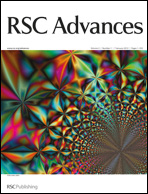Branched polyelectrolyte precursors were obtained on a 100 g scale by coupling ‘living’ poly(2-vinylpyridine) (P2VP) macroanions with linear polystyrene and arborescent polystyrene substrates of generations G0 or G1, functionalized with acetyl groups. Arborescent copolymers with Mn ≈ 5000 or 30 000 side-chains and containing 87–98 mol% of P2VP were thus synthesized. These materials are characterized by a very compact structure, a narrow molecular weight distribution (Mw/Mn = 1.08–1.10), and a roughly geometric increase in branching functionality and molecular weight for successive generations. The copolymers are freely soluble in water and in polar organic solvents such as methanol and N,N-dimethylformamide (DMF) upon protonation by trifluoroacetic acid (TFA), a strong acid. The solutions obtained display properties typical of polyelectrolytes, including strong curvature in plots of reduced viscosity (ηsp/C) versus concentration (C) at low concentrations. The copolymers exhibit larger reduced viscosity increases in methanol than in DMF, and coil expansion apparently varies in the order G1 > G0 > G2. The reduced viscosity of the arborescent polyelectrolyte solutions is much lower than for linear P2VP samples of comparable molecular weights, however, due to the small dimensions and increased structural rigidity of the molecules. The addition of salts to the branched polyelectrolyte solutions further decreases their viscosity and the curvature of the reduced viscosity plots, presumably as a result of charge screening.

You have access to this article
 Please wait while we load your content...
Something went wrong. Try again?
Please wait while we load your content...
Something went wrong. Try again?


 Please wait while we load your content...
Please wait while we load your content...